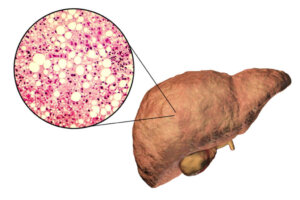4 Warning Signs of Fatty Liver Disease


Escrito y verificado por el nutricionista Saúl Sánchez
Fatty liver disease is a liver disease that can have several different causes. However, the result is always inflammation that jeopardizes the function of this organ and overall health. It’s a problem that can be regulated through food.
It should be noted that there are a series of signs that warn of the appearance of said disease. It’s important to know them and pay attention to them, as detecting the problem in time facilitates its possible solution and reduces the risk of complications.
What is fatty liver disease?
This name refers to a disease that can manifest itself in two different ways:
- Simple fatty liver: Adipose accumulation occurs in the liver tissue, but there’s no cell damage or exaggerated inflammation. It doesn’t usually cause serious complications.
- Non-alcoholic hepatic steatosis: In this case, there’s structural inflammation and cell damage. In the most extreme forms, fibrosis is generated that conditions the functioning of the organ. This problem can even lead to cirrhosis or liver cancer.
Causes of fatty liver disease
Fatty liver disease often has a dietary component. The most frequent cause of this situation is the recurrent intake of alcohol, as evidenced by a study published in the journal Digestive Diseases. In addition, being obese is another risk factor that precipitates its appearance.
Not only is alcohol consumption a trigger for fatty liver, but other eating habits can influence the appearance of the disease. One of them is the regular intake of simple sugars, specifically fructose.
The danger of this carbohydrate doesn’t come from eating fruit as such, but from adding the substance to sugary drinks and soft drinks. This is confirmed by research published in the Journal of Hepatology.
Not only is fructose responsible for liver inflammation that leads to the accumulation of fat in the liver, but glucose intake is also associated with an increased risk of this problem. In general, the consumption of sweets and pastries is capable of increasing the incidence of the disease. For this reason, it’s important to base the diet on fresh foods.

Other risk factors
In addition to the aforementioned dietary habits, there are other risk factors that can increase the predisposition to developing fatty liver. The following stand out:
- Suffering from diabetes, metabolic syndrome, or high blood pressure
- High amount of lipids in the blood
- Frequent ingestion of corticosteroids
- Hepatitis C
As you can see, many of these risk factors are still closely related to diet. Maintaining an adequate body weight reduces the risk of accumulating fat in the liver.
Similarly, regular intake of foods of plant origin and fish is considered protective. However, both diets that are too high in carbohydrates, such as those that are hypercaloric or those that contain industrial foods and trans fats, favor the gain of subcutaneous and organic fat.
Diagnosis of fatty liver
Diagnosing the disease requires carrying out a complete medical history and a physical examination. Blood tests can be useful to detect this problem, as high transaminases are often found in those subjects who have developed the disease.
As a general rule, it’s a silent disease that doesn’t present many symptoms until it’s already very advanced. At this time, it begins to be dangerous and the risk of it becoming cirrhosis is high.
Signs that alert to the presence of fatty liver disease
Below, we’re going to present you with a series of signs that can alert you to the presence or development of fatty liver disease.
1. Regular alcohol consumption
As we’ve stated, the habitual intake of alcoholic beverages is closely related to the accumulation of fat in the liver. Regular drinkers and people who are dependent on this substance are quite likely to reach a situation in which the organ stops working properly, due to inflammation and the accumulation of fatty tissue.
2. Yellow coloring
Many times, a doctor performs a physical exam to look for yellow discoloration of the body or eyes (jaundice). This indicates signs of cirrhosis, which may be closely linked to the formation of fatty liver. However, if this condition occurs, it means that the disease is already advanced and that it’s dangerous.
3. Excess weight
Weight gain may be related to the appearance of fatty liver. The accumulation of subcutaneous fat is usually in line with the presence of lipids in the organs that hinder their function.
For this reason, if you’re overweight, you should start a weight loss plan with a professional. This condition has been shown to be closely related to most of the complex and chronic diseases that are diagnosed today.
4. Imaging tests
As fatty liver disease usually has few symptoms, imaging tests are sometimes necessary to confirm the diagnosis. With these techniques, fibrosis or tissue scarring can be identified, indicating organ involvement. In certain cases, it’s necessary to perform a biopsy to determine the severity of the damage.
Treatment against fatty liver
Despite the fact that the most serious cases are treated with medication, there are a series of dietary measures that must be taken into account in order to reduce inflammation and the accumulation of fatty tissue.
The first guideline is to lose weight. This can be achieved in multiple ways. For example, intermittent fasting has been shown to be effective in this regard. Also, the reduction of carbohydrates in the diet is a point of support. All this, together with the practice of exercise.
The most advisable thing is to suggest a dietary guideline that restricts both alcohol and industrial ultra-processed products. In this way, the consumption of simple sugars, nutrients that are closely related to being overweight and to liver and pancreatic problems, will be regulated. This is evidenced by a study published in Critical Reviews in Clinical Laboratory Sciences.
In addition, trans-fatty acids should also be avoided, as these are associated with systemic inflammation. They come from subjecting dietary lipids to high temperatures, which causes a change in their spatial configuration. At the same time, it’s important to increase the intake of omega-3 fatty acids.

The importance of antioxidants
It’s also essential to ensure a constant supply of antioxidants through the diet. These substances are capable of reducing the appearance of free radicals and modulating inflammation, which directly affects the functioning of many organs, including the liver. To cover the requirements, regular intake of vegetables is recommended, both fruits and vegetables.
There are even certain plants, such as milk thistle, with hepatoprotective activity. It’s a natural treatment complementary to pharmacology that achieves good results, according to research published in the journal Phytotherapy Research.
Finally, keep in mind that while a high protein intake was linked to an increased risk of developing liver problems in earlier times, there’s currently no solid evidence for this. High protein diets are considered safe for health and, in many cases, recommended.
Fatty liver Disease: A disease linked to bad habits
The main risk factors for the development of fatty liver have to do with lifestyle habits. Poor diet and a sedentary lifestyle generate obesity, a perfect breeding ground for the accumulation of fat in the liver area.
If you want to prevent this disease, avoid the consumption of alcoholic beverages and sugary soft drinks. At the same time, try to limit the intake of sweets and industrial ultra-processed foods with high levels of trans fats and sugars.
Instead, include fresh foods, especially vegetables, in your diet. Fruits and vegetables contain antioxidants necessary for the proper functioning of the organs and to prevent the appearance of complex diseases. In turn, fish has fatty acids capable of modulating inflammation in the body, such as those of the omega-3 series.
Don’t forget to exercise frequently to ensure proper muscle function and to avoid gaining fat mass, both subcutaneously and organically.
Fatty liver disease is a liver disease that can have several different causes. However, the result is always inflammation that jeopardizes the function of this organ and overall health. It’s a problem that can be regulated through food.
It should be noted that there are a series of signs that warn of the appearance of said disease. It’s important to know them and pay attention to them, as detecting the problem in time facilitates its possible solution and reduces the risk of complications.
What is fatty liver disease?
This name refers to a disease that can manifest itself in two different ways:
- Simple fatty liver: Adipose accumulation occurs in the liver tissue, but there’s no cell damage or exaggerated inflammation. It doesn’t usually cause serious complications.
- Non-alcoholic hepatic steatosis: In this case, there’s structural inflammation and cell damage. In the most extreme forms, fibrosis is generated that conditions the functioning of the organ. This problem can even lead to cirrhosis or liver cancer.
Causes of fatty liver disease
Fatty liver disease often has a dietary component. The most frequent cause of this situation is the recurrent intake of alcohol, as evidenced by a study published in the journal Digestive Diseases. In addition, being obese is another risk factor that precipitates its appearance.
Not only is alcohol consumption a trigger for fatty liver, but other eating habits can influence the appearance of the disease. One of them is the regular intake of simple sugars, specifically fructose.
The danger of this carbohydrate doesn’t come from eating fruit as such, but from adding the substance to sugary drinks and soft drinks. This is confirmed by research published in the Journal of Hepatology.
Not only is fructose responsible for liver inflammation that leads to the accumulation of fat in the liver, but glucose intake is also associated with an increased risk of this problem. In general, the consumption of sweets and pastries is capable of increasing the incidence of the disease. For this reason, it’s important to base the diet on fresh foods.

Other risk factors
In addition to the aforementioned dietary habits, there are other risk factors that can increase the predisposition to developing fatty liver. The following stand out:
- Suffering from diabetes, metabolic syndrome, or high blood pressure
- High amount of lipids in the blood
- Frequent ingestion of corticosteroids
- Hepatitis C
As you can see, many of these risk factors are still closely related to diet. Maintaining an adequate body weight reduces the risk of accumulating fat in the liver.
Similarly, regular intake of foods of plant origin and fish is considered protective. However, both diets that are too high in carbohydrates, such as those that are hypercaloric or those that contain industrial foods and trans fats, favor the gain of subcutaneous and organic fat.
Diagnosis of fatty liver
Diagnosing the disease requires carrying out a complete medical history and a physical examination. Blood tests can be useful to detect this problem, as high transaminases are often found in those subjects who have developed the disease.
As a general rule, it’s a silent disease that doesn’t present many symptoms until it’s already very advanced. At this time, it begins to be dangerous and the risk of it becoming cirrhosis is high.
Signs that alert to the presence of fatty liver disease
Below, we’re going to present you with a series of signs that can alert you to the presence or development of fatty liver disease.
1. Regular alcohol consumption
As we’ve stated, the habitual intake of alcoholic beverages is closely related to the accumulation of fat in the liver. Regular drinkers and people who are dependent on this substance are quite likely to reach a situation in which the organ stops working properly, due to inflammation and the accumulation of fatty tissue.
2. Yellow coloring
Many times, a doctor performs a physical exam to look for yellow discoloration of the body or eyes (jaundice). This indicates signs of cirrhosis, which may be closely linked to the formation of fatty liver. However, if this condition occurs, it means that the disease is already advanced and that it’s dangerous.
3. Excess weight
Weight gain may be related to the appearance of fatty liver. The accumulation of subcutaneous fat is usually in line with the presence of lipids in the organs that hinder their function.
For this reason, if you’re overweight, you should start a weight loss plan with a professional. This condition has been shown to be closely related to most of the complex and chronic diseases that are diagnosed today.
4. Imaging tests
As fatty liver disease usually has few symptoms, imaging tests are sometimes necessary to confirm the diagnosis. With these techniques, fibrosis or tissue scarring can be identified, indicating organ involvement. In certain cases, it’s necessary to perform a biopsy to determine the severity of the damage.
Treatment against fatty liver
Despite the fact that the most serious cases are treated with medication, there are a series of dietary measures that must be taken into account in order to reduce inflammation and the accumulation of fatty tissue.
The first guideline is to lose weight. This can be achieved in multiple ways. For example, intermittent fasting has been shown to be effective in this regard. Also, the reduction of carbohydrates in the diet is a point of support. All this, together with the practice of exercise.
The most advisable thing is to suggest a dietary guideline that restricts both alcohol and industrial ultra-processed products. In this way, the consumption of simple sugars, nutrients that are closely related to being overweight and to liver and pancreatic problems, will be regulated. This is evidenced by a study published in Critical Reviews in Clinical Laboratory Sciences.
In addition, trans-fatty acids should also be avoided, as these are associated with systemic inflammation. They come from subjecting dietary lipids to high temperatures, which causes a change in their spatial configuration. At the same time, it’s important to increase the intake of omega-3 fatty acids.

The importance of antioxidants
It’s also essential to ensure a constant supply of antioxidants through the diet. These substances are capable of reducing the appearance of free radicals and modulating inflammation, which directly affects the functioning of many organs, including the liver. To cover the requirements, regular intake of vegetables is recommended, both fruits and vegetables.
There are even certain plants, such as milk thistle, with hepatoprotective activity. It’s a natural treatment complementary to pharmacology that achieves good results, according to research published in the journal Phytotherapy Research.
Finally, keep in mind that while a high protein intake was linked to an increased risk of developing liver problems in earlier times, there’s currently no solid evidence for this. High protein diets are considered safe for health and, in many cases, recommended.
Fatty liver Disease: A disease linked to bad habits
The main risk factors for the development of fatty liver have to do with lifestyle habits. Poor diet and a sedentary lifestyle generate obesity, a perfect breeding ground for the accumulation of fat in the liver area.
If you want to prevent this disease, avoid the consumption of alcoholic beverages and sugary soft drinks. At the same time, try to limit the intake of sweets and industrial ultra-processed foods with high levels of trans fats and sugars.
Instead, include fresh foods, especially vegetables, in your diet. Fruits and vegetables contain antioxidants necessary for the proper functioning of the organs and to prevent the appearance of complex diseases. In turn, fish has fatty acids capable of modulating inflammation in the body, such as those of the omega-3 series.
Don’t forget to exercise frequently to ensure proper muscle function and to avoid gaining fat mass, both subcutaneously and organically.
- Mahli A., Hellerbrand C., Alcohol and obesity: a dangerous association for fatty liver disease. Dig Dis, 2016. 1: 32-9.
- Jensen T., Abdelmalek MF., Sullivan S., Nadeau KJ., et al., Fructose and sugar: a major mediator of non alcoholic fatty liver disease. J Hepatol, 2018. 68 (5): 1063-1075.
- Ortega FB., Lavie CJ., Blair SN., Obesity and cardiovascular disease. Circ Res, 2016. 118 (11): 1752-70.
- Stanhope KL., Sugar consumption, metabolic disease and obesity: the state of the controversy. Crit Rev Clin Lab Sci, 2016. 53 (1): 52-67.
- Abenavoli L., Izzo AA., MIlic N., Cicala C., et al., Milk thistle (silybum marianum): a concise overview on its chemistry, pharmacological, and nutraceutical uses in liver diseases. Phytother Res, 2018. 32 (11): 2202-2213.
- Aguilera-Méndez, Asdrúbal. “Esteatosis hepática no alcohólica: una enfermedad silente.” Revista Médica del Instituto Mexicano del Seguro Social 56.6 (2019): 544-549.
- Laclé-Murray, Adriana, et al. “Prevalencia de esteatosis hepática no alcohólica en personas diabéticas tipo 2.” Acta Médica Costarricense 56.1 (2014): 17-22.
- Poles, Natalia, et al. “Ictericia y colestasis.” Clínica-UNR. org. (2008): 1-18.
- Graffigna, Mabel, et al. “Diagnóstico de esteatosis hepática por métodos clínicos, bioquímicos y por imágenes.” Revista argentina de endocrinología y metabolismo 54.1 (2017): 37-46.
Este texto se ofrece únicamente con propósitos informativos y no reemplaza la consulta con un profesional. Ante dudas, consulta a tu especialista.







